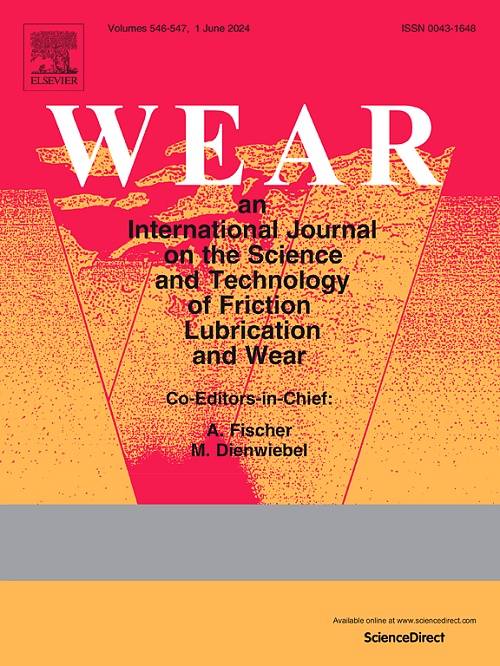夯实效应对冷喷涂Cu-TiC复合涂层磨损行为的影响
IF 6.1
1区 工程技术
Q1 ENGINEERING, MECHANICAL
引用次数: 0
摘要
在冷喷涂过程中,夯实是指冷喷涂颗粒的冲击改变先前沉积材料的组织和性能的效果。研究了夯实对冷喷涂陶瓷增强金属基复合材料(MMC)涂层磨损性能的影响。采用三种原料分别含有0、10 (Cu- 10ct)和70 wt% (Cu- 70ct)的粗TiC粉末和10 wt%的细TiC粉末(Cu- 10ft),沉积了一种Cu涂层和三种Cu-TiC MMC涂层。采用多尺度压痕和划痕粘结强度测试对其力学性能进行了评价。利用x射线衍射和电子背散射衍射分别对涂层在大、小长度尺度上的变形进行了研究。利用球盘式摩擦计研究了干燥空气和氮气环境下的摩擦磨损性能。用拉曼光谱分析了磨损痕迹的化学成分。Cu、Cu- 10ct和Cu- 70ct镀层的沉积效率随TiC比的增加而降低。沉积效率低,表现为夯实增强,孔隙率降低,变形水平升高,显微和纳米硬度增加,内聚强度提高,耐磨性增强。Cu-70cT的磨损率最低。Cu-10fT显示出与Cu-70cT相似的夯实效果。然而,细小的TiC颗粒在Cu- 10ft中沿Cu颗粒-颗粒界面均匀分散,降低了Cu- 10ft的内聚强度,导致涂层在磨损试验中更容易去除。在氮中,由于没有含Cu氧化物的摩擦层,第一体之间的粘附性降低。除Cu-70cT外,涂层在氮气中的磨损率低于干燥空气中的磨损率。Cu-70cT在干燥空气中的磨损率远低于在氮气中的磨损率,这表明稳定的含cu20摩擦层在减少磨损方面具有重要作用。本文章由计算机程序翻译,如有差异,请以英文原文为准。
Role of tamping effect in wear behavior of Cu-TiC composite coatings deposited by cold spray
In the cold spray process, tamping refers to the effect where impacting cold-sprayed particles modify the microstructure and properties of previously deposited materials. The effect of tamping on wear performance was studied for cold sprayed ceramic-reinforced metal matrix composite (MMC) coatings. A Cu coating and three Cu-TiC MMC coatings were deposited, using three feedstocks containing 0, 10 (Cu-10cT) and 70 wt% (Cu-70cT) of coarse TiC powder and one feedstock containing 10 wt% of fine TiC powder (Cu-10fT), respectively. Mechanical properties were evaluated using multi-scale indentation and scratch bond strength testing. X-ray diffraction and electron backscatter diffraction were employed to examine the deformation in the coatings over large and small length scales, respectively. Tribological properties in dry air and nitrogen environments were studied in sliding wear using a ball-on-disk tribometer. Chemical composition on wear tracks was examined by Raman spectroscopy. The deposition efficiency decreased with the increasing TiC ratio for Cu, Cu-10cT and Cu-70cT coatings. Low deposition efficiency manifested as enhanced tamping led to decreased porosity, elevated deformation level, increased micro- and nano-hardness, and improved cohesion strength, resulting in enhanced wear resistance. The lowest wear rate was observed for Cu-70cT. The Cu-10fT showed a similar tamping effect to Cu-70cT. However, the fine TiC particles were uniformly dispersed along the Cu particle-particle interfaces in Cu-10fT, compromising its cohesion strength and leading to easier removal of coating materials during wear test. In nitrogen, adhesion between first bodies was reduced due to the absence of Cu oxide-containing tribolayers. The coatings except for Cu-70cT exhibited lower wear rates in nitrogen than those in dry air. Cu-70cT showed much lower wear rate in dry air than in nitrogen, indicating the important role of the stable Cu2O-containing tribolayers in reducing wear.
求助全文
通过发布文献求助,成功后即可免费获取论文全文。
去求助
来源期刊

Wear
工程技术-材料科学:综合
CiteScore
8.80
自引率
8.00%
发文量
280
审稿时长
47 days
期刊介绍:
Wear journal is dedicated to the advancement of basic and applied knowledge concerning the nature of wear of materials. Broadly, topics of interest range from development of fundamental understanding of the mechanisms of wear to innovative solutions to practical engineering problems. Authors of experimental studies are expected to comment on the repeatability of the data, and whenever possible, conduct multiple measurements under similar testing conditions. Further, Wear embraces the highest standards of professional ethics, and the detection of matching content, either in written or graphical form, from other publications by the current authors or by others, may result in rejection.
 求助内容:
求助内容: 应助结果提醒方式:
应助结果提醒方式:


